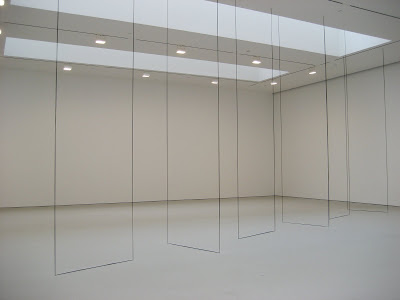.

Fred Sandback’s work defines space by the simplest and most economical of means: acrylic yarn attached at fixed geometric points between the ceiling and the floor, or the wall and the floor. This dry explanation is not enough. You have to see the work. Better still, you have to experience it.
A first look suggests more than what’s actually there: One installation would seem to be an enormous rectangle of glass leaning against a wall; another, mirrors suspended at precise angles to one another. But, no, it’s less. Just the yarn and the space. Then as you approach and then inhabit the space of the work, you realize it’s much more.
It’s too corny to say that you become one with the work, so I won’t say that. (But you do, investing something of yourself into it, if only momentarily, while at the same time taking away somehing of its ordered calm.) In this way, Sandback was the anti-Serra. You’re never closed in, you’re never in danger, real or perceived, that tons of metal will come crashing down on you, and there’s nothing of the vertiginous thrill of curving and canted walls that challenge your relationship to perpendicular. With Sandback’s work, you always know where you stand—but you may not be quite so sure of where it does. The momentary disjunct is transcendent. That's an amazing sleight of hand for a few feet of yarn.
.jpg)
Two more views of the work glimpsed in the opening picture, an articulation of angled space on both sides of the same wall
.jpg)
.jpg)
.
.jpg)
.jpg)
.jpg)
.jpg)
This work was for me the most compelling. Entering the large gallery, I thought I saw mirrors hanging to several inches from the floor. Angled this way and that, they seemed to reflect the walls, the floor, the lights, one another. It was a fleeting perception. Sandback's work is anything but (smoke and) mirrors. But so strong was the illusion of the work being somehow suspended, I had to see for myself that the line, the yarn, was indeed secured into the floor.
.jpg) .
..jpg) .
..jpg) .
..jpg) .
.
